

Out of the Archive: Process & Progress
Essay Excerpts from Exhibition Catalog
“No one is asking to go back to ‘identity politics’ but it seems enough of us are still invested in the need to recognize that ‘Asian American-ness’ is essential. Not essentialist.”
- Karen Su
Spirals of Life: Tomie Arai
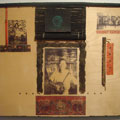
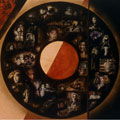
Just two days before, I had attended presentations by Margo and another scholar Alexandra Chang. Chang talked about the history of activist organizations like the Basement Workshop and Godzilla and their efforts to create visibility for Asian American artists and to create space for Asian American art. Chang flashed on screen a shot of a forty five-foot banner by Tomie Arai from a commissioned project called Memories of New York Chinatown (1991), a series of three silk-screened banners developed from archival photos and hung in the Museum of Chinese in the Americas. The man in the banner is Arai’s uncle, the same man in Arai’s mixed-media collage Laundryman (1990). The expanse of the banner is breathtaking. Having recently learned about her work as a community muralist, I was awed by the mark that Arai has left on physical spaces and by her effort to “create an imaginary space where community exists, which may not physically exist anywhere.” I sat up to take special interest in Chang’s next image: Arai’s recreation of a wedding banquet—round table, chairs, table settings—in her installation Double Happiness (1998). Chang described it as “full of the presence of people.” This remark gave me pause because I was wondering, where are the people? It’s an empty space. There are portraits of people, yes, but there are no people physically present. The first time I encountered an image of Double Happiness —I have never seen the actual installation—I immediately wondered whether the people in the portraits were still alive or not. And if they were, did anyone object to their portrait being displayed in this manner? I recalled that there is a Chinese custom that portraits of people are not hung on walls unless the subjects are deceased.
Present Memory: Albert Chong’s Imagining the Past
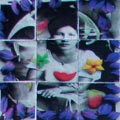
I imagine him patiently and intently transferring the photographs onto the small marble tiles, using his fingers to rub away the photographic paper fiber so as to reveal images reborn through another medium and from another, uncanny context. It’s painstaking work, this labor of love—poring over and translating past images for another re-telling.
This imagined scene has become for me a metaphor for thinking about Albert Chong’s new work. From out of his archives, he has conjured his recent piece Imagining the Past: Photographs & Works 1979-2008, which speaks anew of the ineluctable and enigmatic bonds linking memory and identity. Made up of four-inch square tiles overlaid with images from Chong’s previous series like Color Still Life Photographs, Thrones, Jamaican Portraits, Projections and I-Traits (Self-Portraits), this “photographic installation,” as Chong calls it, is a re-composition and re-contextualization of what lives in the storehouse of memory that the artist has built over time. Translated from digital files to stone, these images as a whole give the viewer a vivid sense of Chong’s artistic process and aesthetics of meaning-making and identity construction, which the critic Thelma Golden has linked to a long line of photographers and artists including Cindy Sherman, Ana Mendieta, Lorna Simpson and Carrie Mae Weems. As in his other works, Chong’s Imagining the Past invites us along on the artist’s exploration of the significance of the photographic image to the construction of personal and cultural memory and identity.
Archival Heaves: Im/Mobilizing Icons and Bodies in the Paintings of John Yoyogi Fortes
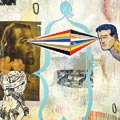
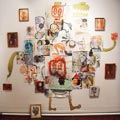
There is a telling moment in the opening seconds of John Yoyogi Fortes’ The Making of Immaculate Rendition (2008), a video that the Filipino American artist posted on YouTube. At the beginning of this meditative, nine–minute video about the making of his painting Immaculate Rendition (2008), Fortes walks into a nondescript studio space with his back turned away from the camera. The opening frames cut between close–up shots of Fortes unlatching a bar of the studio’s sliding metal door and a wide–angle shot of his silhouetted body next to the huge door,which is slightly ajar and close to three times Fortes’ height. One foot propped against the immobile side of the sliding door, Fortes uses the strength of his legs and both his arms, indeed the whole of his body, to slide the door open even further. A deep guttural sound emerges from Fortes. The weight of the door is palpable. With the door open and the light’s intensity increasing, for a split second Fortes’ silhouetted body, positioned at the center of the screen, is momentarily framed by the massive opening of his Mare Island studio in Vallejo, California. His body’s positioning resembles the spatial positioning of the immobilized, chained, and beaten man in Immaculate Rendition. Fortes, himself, says of the painting somewhat jokingly, “I think I could be the guy in chains.”
How To Make Thick Thin The Vertical Seamlessness of Swati Khurana’s Collages
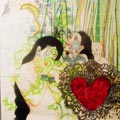
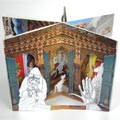
Swati Khurana collects.
Like the character Leon in Fae Ng’s working–class Chinatown novel Bone, Khurana is a “junk inventor” who assembles ordinary and extraordinary things and juxtaposes them in strange ways across a number of mediums: video, sculpture, drawing, and collage.1 Khurana has said of her process: “I’m a collector, so I have too much stuff, too much music, too many tear sheets, too many journals, too many plastic flowers, too many hard drives with too many images and movie files. But I keep it all because I hold onto a piece of text, a source image, or song that I want to incorporate in a piece. It often gets shelved for a while, until another text or image or song comes up that complements the first one, and then I ferociously work to complete it.” She had collected material for four years, including looking through her family’s photograph albums, before she attempted her first collage, which would develop into her Malabar Bride collage series (2005). In so many of her works Khurana creates and exploits the tension between juxtaposition (horizontality) and layering (verticality) that defines the “remixing and remashing” spirit of montage.
Asian American Arts Centre, Inc. is supported, in part with public funds from The New York State Council on the Arts, and The National Endowment for the Arts, New York City Department of Cultural Affairs. With additional funding and support from Lower Manhattan Development Corporation, 9.11 Fund, Lower Manhattan Cultural Council, Manhattan Mini Storage/Edison Properties Inc, the NYC Parks & Recreation’s public art program, Materials for the Arts, NYC Department of Youth & Community Development and the Office of Councilman Alan J. Gerson through CREATE in Chinatown, Inc, New York Cosmopolitan Lions Club, Pearl River Mart, United Orient Bank, Dedalus Foundation, Expedi Printing, Inc., Charles Yuen, Wing Tek Lum, Jody and John Arnhold, Danny C.K. Li, Jeanne Lee Jackson, Linda Peng, Wing Lee Yee, Mikyung Kim, Richard Kenny Esq, John Yu, and the many generous friends of the Asian American Arts Centre.
[ close window ]